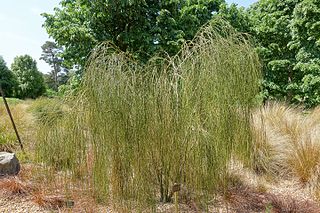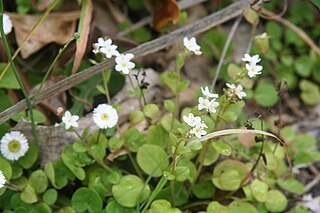
Carmichaelia is a genus of 24 plant species belonging to Fabaceae, the legume family. All but one species are native to New Zealand; the exception, Carmichaelia exsul, is native to Lord Howe Island and presumably dispersed there from New Zealand.

Clianthus, commonly known as kakabeak, is a genus of flowering plants in the legume family Fabaceae, comprising two species of shrubs endemic to the North Island of New Zealand. They have striking clusters of red flowers which resemble the beak of the kākā, a New Zealand parrot. The plants are also known as parrot's beak, parrot's bill and lobster claw – all references to the distinctive flowers. There is also a variety with white to creamy coloured flowers called: "Albus," and a variety with rosy pink flowers called: "Roseus."

Clianthus puniceus, common name kaka beak, is a species of flowering plant in the genus Clianthus of the legume family Fabaceae, native to New Zealand's North Island.

Pachycladon is a genus of flowering plants of the family Brassicaceae, native to Tasmania and the South Island of New Zealand. It contains the following species:

Carmichaelia stevensonii, the cord broom or weeping broom, is a species of plant in the family Fabaceae. It is found only in the north east of the South Island of New Zealand. It is threatened by habitat loss.

Carmichaelia muritai, common name coastal tree broom, is a species of plant in the family Fabaceae. It is found only in the South Island of New Zealand.

Pseudowintera traversii, sometimes called Travers horopito, is a species of woody shrub in the family Winteraceae. The specific epithet traversii is in honor of naturalist Henry H. Travers (1844–1928), son of William Thomas Locke Travers.

Leptinella filiformis, or slender button daisy, is a species of flowering plant in the daisy family, found only in the north-eastern part of the South Island of New Zealand. Thought to be extinct by the 1980s, it was rediscovered growing on a Hanmer Springs hotel lawn in 1998, and in the wild in 2015.
Peter Brian Heenan is a New Zealand botanist.

Myosotis eximia is a species of flowering plant in the family Boraginaceae endemic to the North Island of New Zealand. The species was described by Donald Petrie. Plants of this species of forget-me-not are perennial and erect, and have ebracteate inflorescences with white corollas.

Polypsecadium is a genus of large herbaceous species of plants in the family Brassicaceae, found growing in South America. Most of the species were formerly classified in the genus Sisymbrium.

Myosotis bryonoma is a species of flowering plant in the family Boraginaceae, endemic to the South Island of New Zealand. Heidi Meudt, Jessica Prebble and Michael Thorsen described the species. Plants of this species of forget-me-not are perennial with a creeping habit, bracteate inflorescences, and white corollas.

Myosotis cheesemanii is a species of flowering plant in the family Boraginaceae, endemic to the South Island of New Zealand. Donald Petrie described the species in 1886. Plants of this species of forget-me-not are perennial rosettes with bracteate inflorescences and white corollas.

Myosotis colensoi is a species of flowering plant in the family Boraginaceae, endemic to the South Island of New Zealand. Thomas Kirk described the species in 1896. Plants of this species of forget-me-not are perennial rosettes with bracteate inflorescences and white corollas.

Myosotis brockieisubsp. brockiei is a subspecies of flowering plant in the family Boraginaceae, endemic to southern South Island of New Zealand. Lucy Moore and Margaret Simpson described M. brockiei in 1973. Plants of this subspecies of forget-me-not are perennial rosettes which form caespitose tufts or clumps, with ebracteate, erect inflorescences, and white corollas with exserted stamens.

Myosotis brockieisubsp. dysis is a subspecies of flowering plant in the family Boraginaceae, endemic to southern South Island of New Zealand. Shannel Courtney and Heidi Meudt described this subspecies in 2021. Plants of this subspecies of forget-me-not are perennial rosettes which form stoloniferous mats, with long, ebracteate, erect inflorescences, and white corollas with exserted stamens.

Myosotis pansa subsp. praeceps is a subspecies of flowering plant in the family Boraginaceae, endemic to the North Island of New Zealand. Lucy Moore described the variety M. petiolata var. pansa in 1961, and it was transferred to a subspecies of M. pansa by Heidi Meudt, Jessica Prebble, Rebecca Stanley and Michael Thorsen in 2013. Plants of this species of forget-me-not are perennial rosettes with partially bracteate inflorescences and white corollas with exserted stamens.

Plantago spathulata is a species of flowering plant in the family Plantaginaceae that is endemic to New Zealand. Joseph Dalton Hooker described P. spathulata in 1853. Plants of this species of plantain are perennial with a rosette habit, leaves widest above the middle, up to 4 ellipsoid seeds per capsule, bracts with hairs along the edges, and midribs of bracts and sepals hairy. It is listed as Not Threatened.

Plantago picta is a species of flowering plant in the family Plantaginaceae that is endemic to New Zealand. William Colenso described P. picta in 1890. Plants of this species of plantain are perennial with a rosette habit, leaves widest above the middle, up to 5 ellipsoid seeds per capsule, and bracts with hairs along the edges but otherwise glabrous. Its conservation status is At Risk – Naturally Uncommon.

Kunzea sinclairii, also known as the Great Barrier Island kānuka, is a flowering plant in the myrtle family, Myrtaceae and is endemic to Great Barrier Island in the Auckland Region, New Zealand.



















